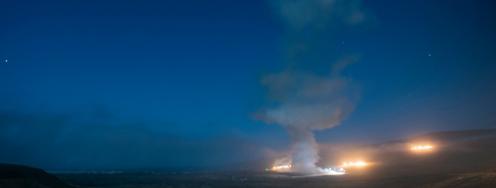India’s Expanding Nuclear Weapons Production Infrastructure
On the radar: U.S. nuclear partner expands bomb capability; Iran holds up its end, again; Amb. Pickering on an Iran deal; Keeping non-nuclear issues off the table; Congress legislates keeping silos, refuses to meet treaty obligations; U.S. de-MIRV’s its last missile; a Non-nuclear Scotland; Ukraine keeps working on Russian missiles; and N. Korea tests a BMD workaround.
June 20, 2014 | Edited by Lauren Mladenka and Geoff Wilson
Arms race - “India is expanding a covert uranium enrichment plant that could potentially support the development of thermonuclear weapons, a defence research group said on Friday, raising the stakes in an arms race with China and Pakistan.”
--“Based on its analysis of commercial satellite images, IHS Jane's has identified what appears to be a new uranium hexafluoride plant that would increase the uranium enrichment capacity of the Mysore facility. The plant would be able to produce a surplus of around 160 kilos a year of uranium enriched to 90 percent purity, IHS Jane's reckons. That is roughly double the needs of the nuclear submarine fleet that India is developing to supplement its land-based missile arsenal - and enough to make five atomic bombs.”
--“Whether or not India uses the plant mainly for fuel for reactors and naval vessels as is sometimes surmised, it adds to India’s already far greater advantage over Pakistan in terms of nuclear weapons production potential," said Mark Fitzpatrick. Full report from Douglas Busvine for Reuters here. http://reut.rs/UUisMI
Testimony - “The impact of an agreement that meets US security needs would enhance US security, as well as that of other nations in the region,” said Ambassador Thomas Pickering in testimony before the House Armed Services Committee. “It would include a significant reduction of Iran’s nuclear program, the institution of an intensive monitoring system, and prevention of Iran from achieving a nuclear weapons capacity… Such an agreement, if it holds, could mark the beginning of a longer process of further efforts by the US and Iran to resolve the many other problems between our two countries.”
--“The opportunity with Iran represents one of the most significant for American diplomacy in this century. The complexities are great. The diplomacy is demanding. The potential strategic gains for the US and the region are real. The consequences of failure will impact our alliances in the region, especially with respect to Israel and our energy interests. And, importantly for all of us here today, questions of war and peace are not far from forefront of our minds. The prospect of the use of force – to deal with a feared Iranian weapon – is not matched by the potential benefits of first exhausting diplomacy.” Read the full transcript here. http://1.usa.gov/1nR5CrT
Iran compliance - “The U.N. nuclear watchdog is expected to report in a monthly update on Friday that Iran is living up to its commitments to curb its atomic activities under an interim pact with six world powers last year,” writes Fredrik Dahl for Reuters.
--Though diplomats gave no details of the forthcoming report, “Last month's IAEA update said Iran had so far reduced the stockpile by around 82 percent and that figure is likely to have risen further since. The amount that remains, less than 40 kg in May, is far below the 250 kg that experts say would be needed for one bomb if processed further.” Full article here. http://reut.rs/1lQLJgk
Tweet - @lrozen: Next Thursday in Brussels RT @Najmeh_Tehran: Zarif says 5+1 will meet next week (without Iran )
Tweet - @Najmeh_Tehran: Zarif says the other side has met commitments under interim deal with delay and reluctantly. Iran expected less bureaucracy.
Preserving silos - “The House of Representatives approved an amendment Wednesday night to the defense appropriations bill for fiscal year 2015...that blocks the Pentagon from using any funding to decommission silos that currently house intercontinental ballistic missiles,” writes Jenn Rowell in the Great Falls Tribune. “The amendment, introduced by Rep. Steve Daines, is similar to amendments on the National Defense Authorization Act for fiscal year 2015, which require all 450 ICBM silos currently used for strategic defense to be retained in at least warm status beyond 2021.”
--“This section would impinge on the president’s authority to determine the appropriate force structure to meet nuclear deterrence requirements, to determine the number of strategic delivery vehicles needed to meet national security requirements, and to implement changes in those forces,” the White House responded in a statement. Full story here. http://gftrib.com/1rfEvYv
De-MIRVed - “In an effort to comply with New START, a nuclear arms reduction treaty with Russia, the Air Force completed work to reconfigure all of the nation’s Minuteman III missiles.”
--“The Minuteman ICBMs were previously configured to carry up to three multiple independently targetable re-entry vehicles, MIRVs, that were each armed with a nuclear warhead and able to hit three separate targets from a single missile launch. On June 16, maintainers at Malmstrom removed the last of the extra MIRVs on a Minuteman Missile in the 341st Missile Wing’s inventory.” Jenn Rowell has the story in the Great Falls Tribune. http://gftrib.com/1ysi3Qu
Congress’ role - “A handful of groups supporting diplomacy with Iran have drafted a letter to the Chair and Ranking Member of the House Foreign Affairs Committee asking them to reconsider their demand that a final nuclear deal with Iran include provisions unrelated to Tehran’s nuclear program,” writes Ben Armbruster in ThinkProgress. “The National Iranian American Council (NIAC), along with the Friends Committee on National Legislation (FCNL) and Win Without War, have drafted a letter in response, seeking to clarify that their intent isn’t aimed at rejecting a deal.”
--“As written, [the Royce-Engel letter] could be understood as implying that, unless a nuclear deal also includes non-nuclear elements on the U.S. agenda with Iran, Congress will refuse to lift any sanctions. The notion that Congress would choose to keep sanctions in place rather than secure an agreement that prevents an Iranian nuclear weapon is alarming, and we urge you to clarify that this is not the implication of your letter. Demanding that non-nuclear issues be added to the nuclear negotiations at this time will only ensure that we get no deal and face the prospect of an unconstrained Iranian nuclear program or a disastrous war opposed by the American people.” Full piece here. http://bit.ly/1st7Vqa
A Scotland without nukes - “In London, talk of an independent Scotland without nuclear weapons has been met with a decidedly chilly reception,” writes Jeffrey Lewis in for Foreign Policy. “That's because Scotland is where the United Kingdom keeps its nuclear weapons for the moment. Currently, Britain deploys four nuclear-powered ballistic missile submarines, which carry as many as 160 warheads and are based at Naval Base Clyde in Faslane, in southwestern Scotland. The U.K. stores warheads for deployment less than five kilometers away at the Royal Naval Armaments Depot in Coulport.”
--“An independent Scotland would mean it's moving time. But the question is where the Royal Navy would be able to relocate the Faslane and Coulport facilities. One school of thought suggests that this might be the last straw for nuclear weapons in the United Kingdom. Of all the nuclear weapon states, the United Kingdom is winning the limbo contest -- how low can you go. Foreign Secretary William Hague has even stated that the size of the U.K. stockpile is a slim 225 warheads and has committed the country to stay below that. Its next cut would probably be to zero. And, today, many Britons are just not so convinced that they will get good value for the cost of replacing their aging fleet of Trident ballistic missile submarines.”
--“At the end of the day, this debate says something very interesting about the value of nuclear weapons and the political will of states to keep them. We are told repeatedly that nuclear weapons are important symbols of status and that they offer an incomparable form of deterrence and provide insurance in an uncertain world. We are also told that disarmament is hard because no state wants to give up nuclear weapons. What does it say about those claims that the citizens of an independent Scotland don't want nuclear weapons?” Full story here. http://atfp.co/1lbkxxp
Nuclear fuel repository - “Kazakhstan and a U.N. agency may finalize terms this year for opening a new multilateral nuclear-fuel repository,” Global Security Newswire reports. “A sales official for the Ulba Metallurgical Plant said the Soviet-era facility would host the fuel bank under a pending agreement between Kazakhstan and the International Atomic Energy Agency... The proposed multinational facility is intended to provide emerging atomic-power programs with a reliable fuel source, eliminating any need for additional countries to pursue production capabilities that can also generate material for weapons.” Full story here. http://bit.ly/TdVhvl
Continuing service - “Ukraine reportedly has not stopped providing strategic missile-maintenance services to Russia, despite an order by Kiev to halt all joint military cooperation,” Global Security Newswire reports. “Ukraine's missile design bureau Yuzhnoye and the country's Yuzhmash plant perform maintenance services for Russia's RS-20 ‘Satan’ intercontinental ballistic missile. That cooperation, which dates back to Soviet times, has not stopped, regardless of Kiev's proclamation, an unidentified official at Yuzhnoye was reported to have told the Russian Izvestia newspaper.” Read the full article here. http://bit.ly/1lF369J
Countermeasures - “North Korea was likely assessing its ability to evade missile defenses when it test-fired two ballistic missiles in March,” reports Global Security Newswire. “North Korea fired the Rodong missiles at a higher than usual launch angle in order to shorten their maximum range,” an unidentified high-ranking South Korean military source said. “By carrying out such a test, North Korea appears to have come up with a way not to be caught by either the South Korean or American missile interception system when launching an attack against South Korea with its mid-range missiles.”
--“Seoul does not presently have the ability to counter Rodong weapons, the South Korean defense ministry said. The Patriot Advanced Capability 3 interceptors that the South is planning to acquire would have a difficult time countering a Rodong if it were traveling at a high altitude similar to those missiles launched in March, the ministry acknowledged.” Full story here. http://bit.ly/1nSyU9K
Quick-hits:
--“The Days After a Deal with Iran: U.S. Policies of Hedging and Engaging” by Lynn Davis for RAND. http://bit.ly/1rfPK33
--“Readers React About that Missile Shield” in the Los Angeles Times. http://lat.ms/1pQ12xf
--“UK Atomic Weapons Establishment Launches SGI Supercomputer” in The Wall Street Journal. http://on.wsj.com/TdZnDv
--“Iran Nuclear Talks Tough, Intense as Major Gaps Remain” by Laurence Norman for The Wall Street Journal. http://on.wsj.com/1qme5En
Events:
--“The Iran Nuclear Deal and the Impacts on its Neighbors.” Discussion with Abdullah Baadood, Salah Elzein, Bijan Khajehpour, Afshin Molavi, David Ottaway, and Marina Ottaway. June 23 from 9:30-12:00 at the Wilson Center, 5th floor, Reagan Building, 1300 Pennsylvania Ave. NW. RSVP here. http://bit.ly/1lsjx99
--“PONI Breakfast with Kirk Donald.” Breakfast discussion with former National Nuclear Security Administration Deputy Administrator Kirk Donald. June 26 from 9:00-10:30 at the Center for Strategic and International Studies, 1616 Rhode Island Ave. NW. RSVP here. http://bit.ly/1owrOLA
--“Toward a Comprehensive, Effective Nuclear Deal with Iran?” Discussion with Daryl Kimball, Greg Thielmann, Kelsey Davenport, and Frank von Hippel. June 26 from 10:00-12:00 at the Carnegie Endowment for International Peace, Choate Room, 1779 Massachusetts Ave. NW. RSVP here. http://bit.ly/1p9kz8a
--“Aegis Sea-Based Missile Defense: Present Status and Future Recommendations.” Discussion with John James, Rear Adm. James Kilby, Ron O’Rourke, Henry Cooper, and Robert Soofer. June 26 from 12:00-2:00 at SVC 201-00, Capitol Visitor Center. RSVP by email to Polly Parke at pparke@ifpa.org



